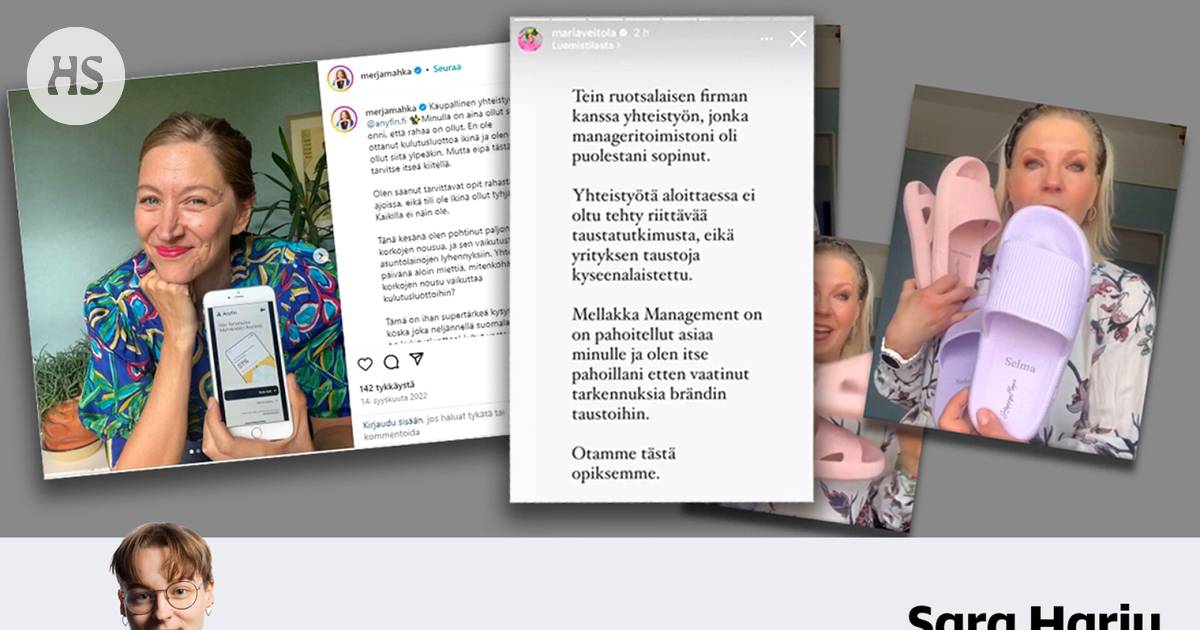If influencers outsource their responsibility for the ethics of advertising campaigns to marketing agencies, it will be difficult for them to appear credible in the eyes of the public, writes culture journalist Sara Harju.
Influencers the biggest selling point is authenticity and reliability. That’s why Followers believe them, and that’s why companies use them as their advertising faces.
Recently, several influencers had to re-examine their commercial collaborations, when sanitary sandals were revealed to be a dime a dozen and a means of saving to be consumer credit.
One of the advertisers of Happy flops sandals was well-known as a journalist and social media influencer Maria Veitola. When footwear began to be criticized for shortcomingsVeitola apologized for her lack of background work on Instagram.
Veitola has told before In an interview with Helsingin Sanomat, that he does not consider the journalist’s work and commercial collaborations to be problematic. He did not agree to comment on the sandal case to HS, but directed requests for comments to his manager’s office.
Another similar case is related to the consumer credit service Anyfin, which, among others, is a columnist and an investment blogger Merja Mähkä and Mimmit invests media advertised as a means of saving. When the consumer ombudsman found Anyfin that influencer marketing was against the law, Mähkä deleted his post and Mimmit invests apologized for the misleading advertising. Founder and CEO of Mimmit invests company Pia-Maria Nickström told HS that the cooperation campaign was done through the marketing office.
Supplier is not a protected professional title, and most influencers do not even claim to be journalists. For example, Mimmit invests describes itself as a “multichannel media”.
In social feeds, however, journalism and content that looks like journalism are mixed. Individual media personalities can often tackle interesting topics faster and more easily than media houses.
Increasing the multi-voicedness of the media environment is important, but when influence and editorship are combined, the importance and responsibility of source criticism is emphasized. When a journalistic story is corrected, it is not removed from the network, but the correction is reported in connection with the story. The influencer can remove incorrect information and paid advertising without leaving a trace.
Bodies that publish journalistic content can be identified by the fact that they are committed to ethical self-regulation. Journalist’s instructions has been reformed to better fit the current media environment: according to them, the journalist may not cover topics that involve his own commercial cooperation.
Monet in addition to journalism, freelancers do communications in order to get enough income. Journalisti-lehti told already a few years ago, that suppliers are doing more and more commercial cooperation with companies.
Media researcher Elina Tolonen The University of Tampere says that in the current media environment, the boundaries of different roles are becoming increasingly difficult to understand. According to him, a person working as an influencer and journalist can have clear principles and systems for acting in different roles, but the challenge is how to make the differences between the roles visible to the public.
“When these people appear and become known as certain individuals, it can be difficult from the audience’s point of view to understand when they are acting as an influencer and when as a journalist.”
Even if there are several roles, they are attached to one brand. The public may not be able to find out who is trying to do journalism and who is just advertising.
When the boundaries between journalism and influence become blurred, advertising collaborations gone wrong can erode the credibility of journalism. Background work revealed as insufficient is not good for influencers’ brands either.
